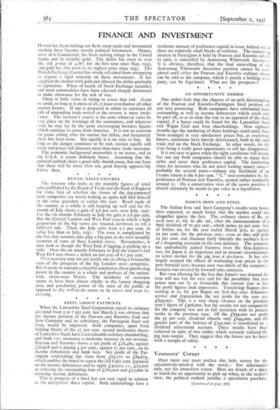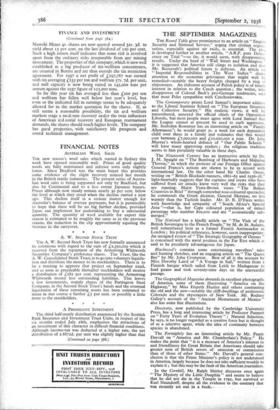FINANCE AND INVESTMENT
HITLER has been making our flesh creep again and investment markets have become merely political barometers. Money, most of it Continental, has been seeking refuge in the United States and in metallic gold. The dollar has risen to over the old parity of 4.86; for the first time since May, 1935, and gold has also risen to its highest price since 1935. The British Exchange Control has wisely refrained from attempting to impose a rigid restraint on these movements. It has supplied the market with gold and allowed the dollar gradually to appreciate. Prices of nearly all Stock Exchange securities and most commodities have been adjusted sharply downward to make allowance for the risk of war.
There is little value in trying to assess that risk. Great or small, so long as it exists at all, it must overshadow all other market factors. If one is prepared to admit its existence all talk of impending trade revival or the reverse is mere irrele- ance. The investor's course is the same whatever value he may place on the warnings of the economists, and whatever tore he may lay by the quite encouraging business figures which continue to come from America. It is not an occasion for panic selling after the market has fallen, and fortunately ...here has been none. But equally it is no time to buy. • SO long as the danger continues to be real, market squalls will recur and prices will discount more than mere trade recession.
The economic background meanwhile is no worse, and in the U.S.A. it seems definitely better. Assuming ;hat the political outlook clears a good rally should ensue, but one fears that there will be more than one good buying opportunity before then. * * *
RETAIL SALES FIGURES
The investor who looks to the monthly figures of retail sales published by the Board of Trade and the Bank of England for some hint of whether the shares of the departmental store companies are worth looking at again, will find himself in the same quandary as earlier this year. Retail trade of the country as a whole is still keeping up well and for the month of July shows a gain of 3.6 per cent. over July, 1937. For the six months February to July the gain is 2.6 per cent. But the Central London and West End area, in which a high proportion of the big stores are situated, continues to tell a different tale. There the July sales were 2.7 per cent. in value less than in July, 1937. The issue is complicated by the fact that summer sales play a big part in the total monthly turnover of some of these London stores. Nevertheless, it does look as though the West End, if lagging, is picking up a little. Over the six months February to July the Central and West End area shows a deficit on last year of 6.7 per cent.
That recovery may not yet justify one in taking a favourable view• of the prospects of the big London store companies. But it seems to warrant a cheerful conclusion about purchasing power in the country as a whole and perhaps of the nation- wide chain-store Shares. The incidence of recession seems to have been almost wholly in the luxury shopping area, and purchasing power of the mass of the public as opposed to the well-to-do seems to be intact and even in- creasing.
* * * * STEEL GROUP PAYMENTS
When the Lancashire Steel Corporation raised its ordinary dividend from 5 to 7 per cent. last March it was obvious that the income position of the Pearson and Knowles Coal and Iron Company and its subsidiary, the Partington Steel and Iron, would be improved. Both companies, apart from holding blocks of the 51 per cent. second preference shares of Lancashire Steel, have a considerable ordinary shareholding, and both now announce a moderate increase in net revenue. Pearson and Knowles shows a net profit of £28,480, against £20,978 and is paying 4 per cent., against 21 per cent., on its income debentures and bank loan. Net profit of the Par- tington undertaking has risen from £63,777 to. £89,873, which enables the board to repeat the full 6 per cent. payment on the income debentures and to apply £4o,o30, i.e., £25,000 in reducing the outstanding loan of £rEo,oco and £15,000 in reducing income debentures.
This is progress of a kind but not very rapid in relation to the cornranies' share capital. Both undertakings have a moderate amount of preference capital in issue, behind which there are relatively small blocks of ordinary. The controlling interest in Partington is held by Pearson and Knowles which, in turn, is controlled by Armstrong Whitworth Securities. It is obvious, therefore, that the final unravelling of the Armstrong Whitworth Securities position cannot be com- pleted until either the Pearson and Knowles ordinary shares can be sold or the company, which is purely a holding com- pany, can be liquidated. What are the prospects ?
* * * *
AN OPPORTUNITY MISSED
One rather feels that the chances of an early disentangling of the Pearson and Knowles-Partington Steel position are not very promising: Both companies have substantial loans outstanding as well as income debentures which could only be paid off, so as to clear the way to an appraisal of the share capital, if a buyer could be found for the Lancashire Steel and Wigan Coal and Iron shareholdings. Now eighteen months ago the marketing of these holdings could easily have been- arranged at very satisfactory prices but, as everybody knows, conditions have latterly deteriorated, both in the steel trade and on the Stock Exchange. In other words, for the time being a really good opportunity to sell has disappeared.
It is not easy to guess when the right conditions will return, but one day both companies should be able to repay their debts and cover their preference capital. The interesting share for investors who do not mind locking money away— probably for several years—without any likelihood of an income return is the 6 per cent. " C " non-cumulative 6s. 8d. preference of Pearson and Knowles, quoted rather nominally around is. On a conservative view of the assets position it should ultimately be worth its par value in a liquidation.
* * * *
INDIAN IRON AND STEEL
The Indian Iron and Steel Company's results were better than expected, so much better that the market could not altogether ignore the fact. The ordinary shares of Rs. to each rose 2S. 6d. to 48s. 9d., after the announcement of a final dividend of 20 per cent., which makes 35 per cent. free of Indian tax for the year ended March 31st, as against 20 per cent. for the previous year ; even so they still yield to per cent. and discount fairly liberally the market's fears of a deepening recession in the iron industry. The company has undoubtedly gained business from the Sino-Japanese war, for Japan is an important and in present circumstances an active market for the pig iron it prcduces. It has also largely escaped the effects of weakening iron prices in the past financial year, because over two-thirds of the company's business was covered by forward sales contracts.
But even allowing for the fact that Japan's war demand for iron will not last for ever and for the possibility that iron prices may not be so favourable this current year as last the profit figures look impressive. Translating Rupees into sterling at is. 6d. per Rupee we find that after debenture service and depreciation the net profit for the year was £839,000. This is a very sharp advance on the previous year's figure of £3o6,000, but the results are not comparable for the company was not in full operation with its present works in the previous year. Of the £839,000 net profit the 35 per cent. dividend absorbs only £644,000, and the greater part of the balance of £191,000 is transferred to a dividend adjustment account. These results have been achieved in spite of two strikes which seriously reduced the pig iron output. They suggest that the future can be faced with a margin of safety.
* * * *
Venturers' Corner Once more one must preface this little survey for the speculatively-minded with the words : For information only, not for immediate action. Here are details of a share to watch for an opportunity to pick up when, in the reader's view, the political outlook justifies a speculative purchase.
(Continued on page 336) FLNANCE AND INVESTMENT (Continued from page 384.) Mawchi Mines 4s. shares are now quoted around 32s. 3d. to yield about 15 per cent. on the last dividend of 120 per cent. Such a high return itself indicates that some risk is involved apart from the ordinary risks inseparable from any mining investment. The properties of this company, which is now well established as a big producer of tin-wolfram concentrates, are situated in Burma and are thus outside the tin restriction agreement. For 1937 a net profit of £297,787 was earned with tin averaging £235 per ton and wolfram 57s. 7d. per unit, and mill capacity is now being raised to 145,000 tons per annum against the 1937 figure of 125,000 tons.
So far this year tin has averaged less than £200 per ton and wolfram has fallen well below last year's level, but even so the indicated fall in earnings seems to be adequately allowed for in the market quotation for the shares. If, as still seems a reasonable possibility, the tin and wolfram markets stage a methrate recovery under the twin influences of American ind istrial recovery and European rearmament demands, the shares should reach higher levels. The company has good properties, with satisfactory life prospects and sound technical management.







































 Previous page
Previous page